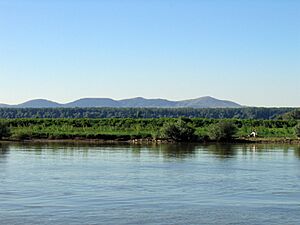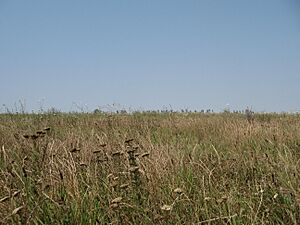Boian culture facts for kids
| Alternative names | Giulești–Marița culture Marița culture |
|---|---|
| Horizon | Old Europe |
| Geographical range | Danube Valley: modern-day Romania and Bulgaria. |
| Period | Neolithic, Chalcolithic |
| Dates | 4300–3500 BC |
| Preceded by | Dudești culture Linear Pottery culture |
| Followed by | Hamangia culture, Gumelnița culture, Cucuteni-Trypillia culture |
The Boian culture (active from about 4300 to 3500 BC) was an ancient group of people who lived in Southeast Europe during the Neolithic (New Stone Age). They are also known as the Giulești–Marița culture or Marița culture. You can find traces of their settlements mainly along the lower part of the Danube River in what is now Romania and Bulgaria. This makes them a Danubian culture, meaning they lived near the Danube.
Contents
Where the Boian People Lived
The Boian culture started in a flat area called the Wallachian Plain in southeastern Romania, north of the Danube River. As they grew, their settlements spread out. They lived in areas like the Bărăgan Plain and the Danube Delta in Romania. They also lived in Dobruja, which is in eastern Romania and northeastern Bulgaria. Their homes reached the Danubian Plain and the Balkan Mountains in Bulgaria.
Their territory stretched quite far! To the west, they reached the Jiu River in south-central Romania. To the north, they went up to the Chilia branch of the Danube Delta, near the border with Ukraine and the Black Sea coast. To the south, they reached the Rhodope Mountains and even the Aegean Sea in Greece.
The main place where archaeologists first studied the Boian culture is on an island in Lake Boian. This lake is in the Muntenia region, on the Wallachian Plain, north of the Danube River.
The Boian Timeline
The Boian culture developed from two older groups of people. One was the Dudeşti culture, which came from Anatolia (modern-day Turkey). The other was the Musical Note culture, also known as the Linear Pottery culture, which came from areas in southeastern Poland and western Ukraine.
Phases of the Boian Culture
The Boian culture is usually divided into four main periods, or phases. Each phase is named after an important archaeological site where discoveries were made:
- Phase I – Bolintineanu Phase: This was from about 4300 to 4200 BC.
- Phase II – Giulești Phase: Also called the Giulești-Boian culture, from 4200 to 4100 BC.
- Phase III – Vidra Phase: This period lasted from 4100 to 4000 BC.
- Phase IV – Spanțov Phase: Also known as the Boian-Gumelnița culture, from 4000 to 3500 BC.
How the Boian Culture Ended
The Boian culture didn't just disappear. It slowly changed into the Gumelnița culture. The Gumelnița culture also took ideas from another group, the Vădastra culture.
However, some Boian people moved northeast along the Black Sea coast. There, they met the late Hamangia culture. These two groups eventually joined together to form the Cucuteni-Trypillian culture.
The time when the Boian culture was changing into the Gumelnița culture is called a transitional period. During this time, you can find similarities between both cultures. This is why Phase IV of the Boian culture and Phase A1 of the Gumelnița culture are sometimes seen as one continuous period. Because of this, experts often use the term Boian-Gumelnița culture for this specific time.
Boian Settlements and Homes
Archaeological sites of the Boian culture are often found near rivers and lakes. These areas had rich floodplains, which meant the soil was very good for farming.
The Boian people built different kinds of homes over time.
- In Phases I and II, their homes were simple, oval-shaped shelters. These were like lean-tos or dugouts, built into river banks or ledges.
- In Phases III and IV, their homes became more advanced. They built small houses with raised wooden floors.
- The third type of house was larger and rectangular. Some were up to 7 by 3.5 meters (23 by 11.5 feet). These were made of wattle and daub (a mix of woven branches and mud) with wooden floors covered in clay. They had roughly-thatched roofs and were built on the ground.
During Phases III and IV, the first real settlements started to appear. These were often built on high, steep terraces or headlands above the rivers or lakes. The houses in these later settlements had more advanced features. They had raised floors, and their inside walls were painted with red and white geometric designs. They also had painted clay furniture and indoor clay ovens. Later settlements sometimes had signs of defenses, like deep, wide ditches around them.
In Phase III, settlements showed signs that some houses were bigger or in better locations than others. This suggests there might have been a social order. In Phase IV, most houses were built above ground, not underground. Settlements grew to have up to 150 people.
How the Boian People Lived
The Boian people got their food and resources in several ways. They practiced agriculture (farming) and animal husbandry (raising animals). They also went hunting, gathering wild plants, and fishing.
Their settlements were close to forests and open grasslands (steppe). This gave them a good supply of wild animals to eat, wood for fires, and materials for tools and homes. Being near rivers, lakes, and marshes also provided them with birds and fish. They could also find stone and clay from the river banks to make tools and pottery.
Archaeologists have found evidence of many animals that the Boian people used. They either ate these animals or used their fur, bones, or meat for tools and clothes. Some of these animals included:
- Wild cattle (like aurochs) and domestic cattle
- Wild dogs (like gray wolf) and domestic dogs
- Goats and domestic sheep
- Deer (like roe deer and red deer)
- European beavers and European badgers
- Wild horses and European hares
- Domestic pigs and wild boars
- Freshwater mussels
- Red foxes
Boian Art and Tools
The pottery of the Boian culture showed influences from the older cultures they came from. Their pots had checkerboard patterns and fluted designs from the Dudești culture. They also had small triangles bordering lines, which came from the Musical Note Linear culture.
After firing, their pottery was polished. It was decorated with carved or raised geometric designs. Often, they used white clay as an inlay to make the designs stand out against the dark grey or black clay of the pot. Sometimes, they even used red clay for decoration in certain areas. In Phase III, they started using graphite paint to decorate their pottery. They probably learned this method from the Marica culture to the south. The Boian people kept improving their pottery skills until Phase III, after which the quality started to decline.
The Boian culture also used stone tools throughout their existence. Archaeologists have found many pieces of waste stone (called debitage) next to different types of flint and polished stone tools.
Towards the end of the Boian culture's time, people started finding copper artifacts. These were made from high-quality copper found in the Balkan Mountains of Bulgaria. This shows that the Boian culture learned how to work with copper. Because of this, they helped bridge the gap between the Neolithic (Stone Age) and the Copper Age.
Unlike some later cultures, not many sculptures or figurines have been found at Boian sites. However, the oldest bone figurine ever found in Romania was discovered at the Cernica site. It dates back to Phase I of the Boian culture.
See also
- Prehistoric Romania
- Prehistory of Southeastern Europe
- Neolithic Europe





